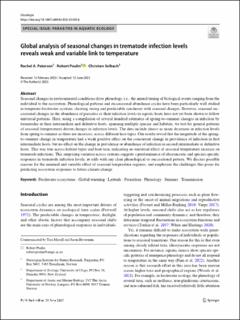| dc.contributor.author | Paterson, Rachel | |
| dc.contributor.author | Poulin, Robert | |
| dc.contributor.author | Selbach, Christian | |
| dc.date.accessioned | 2023-07-04T09:57:32Z | |
| dc.date.available | 2023-07-04T09:57:32Z | |
| dc.date.created | 2023-07-03T11:08:53Z | |
| dc.date.issued | 2023 | |
| dc.identifier.issn | 0029-8549 | |
| dc.identifier.uri | https://hdl.handle.net/11250/3075516 | |
| dc.description.abstract | Seasonal changes in environmental conditions drive phenology, i.e., the annual timing of biological events ranging from the individual to the ecosystem. Phenological patterns and successional abundance cycles have been particularly well studied in temperate freshwater systems, showing strong and predictable synchrony with seasonal changes. However, seasonal successional changes in the abundance of parasites or their infection levels in aquatic hosts have not yet been shown to follow universal patterns. Here, using a compilation of several hundred estimates of spring-to-summer changes in infection by trematodes in their intermediate and defnitive hosts, spanning multiple species and habitats, we test for general patterns of seasonal (temperature) driven changes in infection levels. The data include almost as many decreases in infection levels from spring to summer as there are increases, across diferent host types. Our results reveal that the magnitude of the springto-summer change in temperature had a weak positive efect on the concurrent change in prevalence of infection in first intermediate hosts, but no efect on the change in prevalence or abundance of infection in second intermediate or defnitive hosts. This was true across habitat types and host taxa, indicating no universal efect of seasonal temperature increase on trematode infections. This surprising variation across systems suggests a predominance of idiosyncratic and species-specifc responses in trematode infection levels, at odds with any clear phenological or successional pattern. We discuss possible reasons for the minimal and variable efect of seasonal temperature regimes, and emphasise the challenges this poses for predicting ecosystem responses to future climate change | en_US |
| dc.language.iso | eng | en_US |
| dc.rights | Navngivelse 4.0 Internasjonal | * |
| dc.rights.uri | http://creativecommons.org/licenses/by/4.0/deed.no | * |
| dc.subject | Freshwater ecosystems | en_US |
| dc.subject | Global warming | en_US |
| dc.subject | Latitude | en_US |
| dc.subject | Parasitism | en_US |
| dc.subject | Phenology | en_US |
| dc.subject | Summer | en_US |
| dc.subject | Transmission | en_US |
| dc.title | Global analysis of seasonal changes in trematode infection levels reveals weak and variable link to temperature | en_US |
| dc.title.alternative | Global analysis of seasonal changes in trematode infection levels reveals weak and variable link to temperature | en_US |
| dc.type | Peer reviewed | en_US |
| dc.type | Journal article | en_US |
| dc.description.version | publishedVersion | en_US |
| dc.rights.holder | © 2023 The Authors | en_US |
| dc.subject.nsi | VDP::Matematikk og Naturvitenskap: 400::Zoologiske og botaniske fag: 480::Økologi: 488 | en_US |
| dc.source.journal | Oecologia | en_US |
| dc.identifier.doi | 10.1007/s00442-023-05408-8 | |
| dc.identifier.cristin | 2160266 | |
| cristin.ispublished | true | |
| cristin.fulltext | original | |
| cristin.qualitycode | 2 | |

